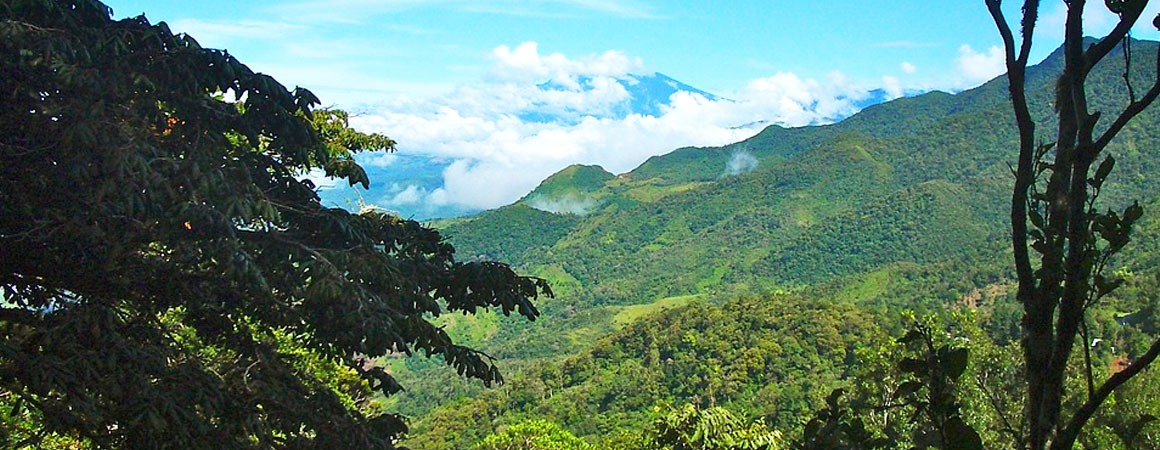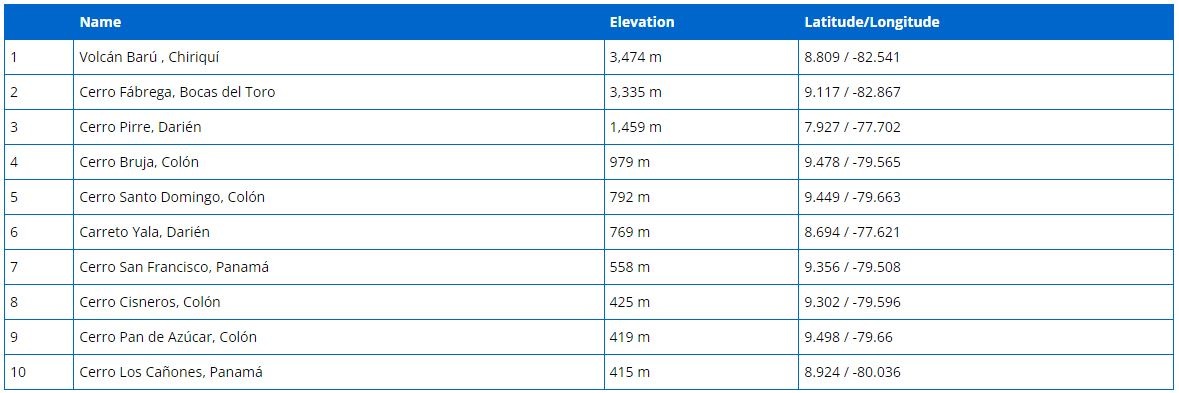Panama's Mountains & Highlands

Panama’s Mountain and highlands offer cool weather throughout the year, and have become a very popular retirement destination for people from all over the world, especially North Americans and Europeans.
The Cordillera Central forms a disconnected backbone from Costa Rica in the West, gradually descending to Panama City. Further east towards Colombia, the range becomes known as the Serrania de Tabasará or Cordillera de San Blas. For those who think that as Panama forms a land bridge between North and South America it must run north to south – think again! The Republic of Panama actually runs west to east in the shape of a recumbent “S”.
The Panama Canal was constructed at one of the lowest points to carry ships across the continental divide. The Cordillera Central divides the Republic of Panamá into the flat coastal lowlands of the Pacific slopes and those of the Caribbean slopes and very much affects the weather patterns of the country. Generally there is more rain on the Caribbean side where the mountains form a barrier for the warm moist trade winds. The majority of the population lives on the Pacific side of the country, southwest of Panamá City.
Altitude affects the temperature so the higher elevations offer cool and pleasant respite from the tropical lowlands with their enervating heat. Panamá’s highlands are fast becoming some of the hottest spots for adventure vacations, with world-class whitewater rafting, kayaking, hiking, and rock climbing topping the bill. A pristine environment and few fellow travelers make Panama is a stunning destination for the adventure trip of a lifetime. The mountains and highlands of Panama are home to an incredible variety of flora, fauna and animal species. These are the only mountains between northern Central America and the Colombian Andes, this isolation leads to many endemic species of birds. In the Chiriqui Highlands you will find two of Panama’s finest national parks.
On the Cocle Mountains several projects of second homes or for retired people who look a quieter style of life without losing comfort of modern life are being developed such as The Bristol Villas. Which is this comfort? Living in the country provides the opportunity to have a 18 hole golf course, stables, tennis court, etc. Coclé also offers beaches and large prairies where salt, rice and sugar are produced as well as cattle are raised. Furthermore, they have a great handicraft production. All of this it is just 90 minutes away from the center of the city of Panamá.
Panama – Highest Mountains

Baru Volcano National Park
Volcan Baru National Park is located in the Province of Chiriqui, with a surface of 14,325 hectares (35,000 acres) and has a highly valuable geological and ecological scenic landscape that protects a biological diversity with some unique species of this area. In this park you will find tropical rainforest landscapes with highlands species and the remains of the last blast of the Baru Volcano that happened millions of years ago.
This park is not only home to the Volcan Baru volcano but also to the resplendent quetzal, one of the few places in the world where you can almost be sure to see one if you take a good guide. A favorite of the Audubon Society tours, birding here is exceptional, and wild life abounds. A strenuous hike will take you to the top of the highest of the seven craters from where, on a clear morning, you can see both the Pacific Ocean and the Caribbean.
From Panama City you can take a 1-hour flight or a 6-hour drive to David, followed by a 30-minute trip by car to Boquete at 40 kilometers or 25 miles. From Boquete you can reach the Park’s main entrance, the route to the top or the many trails
La Amistad National Park
The park lies in the foothills and mountains of Cordillera de Talamanca between the mountain ranges of Las Vueltas, Cartago and Echandi on the Panamanian/Costa Rican border. Half of the 407,000 hectares of the Friendship Park is in Panama and the rest in Costa Rica.
The Cordillera de Talamanca is the highest and wildest non-volcanic mountain range in Central America. It was formed by the folding of the Earth’s crust and uplifting activity that created the land dividing the Pacific from the Caribbean. A long period of marine deposition in the shallow surrounding seas up until the Middle Miocene was followed by a period of marine volcanism, which included the uplifting of the whole area to some 4,000 m above sea level. Subsequent erosion due to heavy rainfall has created a rugged topography. During the Quaternary period, glaciers carved cirque lakes and steep valleys on the slopes of Chirripo National Park, the only area in Central America to show signs of glaciation.
Entrances to the park are found in Cerro Punta, Guadeloupe on the Volcan side of Vulcan Baru and at Wetzo near Changuinola. This is a world heritage site and is home to numerous species of plants, birds and animals. The biodiversity includes seven of the twelve classified life zones.
For more information on Panama’s national parks, click here.
Boquete and the Chiriqui Highlands
Boquete is a small town on the Caldera River, in the green mountain highlands of Panama, in western-most Chiriquí Province, about 60 kilometers (37 mi) from the border with Costa Rica. Because of its altitude, some 1,200 meters (3,900 ft) above sea level, its climate is cooler than that of the lowlands. Its scenic location, temperature, and natural environment make it popular with Panamanians and attract tourists from all over the world.
Boquete boasts a very lively music and arts scene. The annual Boquete Jazz Festival was founded in 2007 being the second largest jazz festival in the country after the Panama City Jazz Festival. Having been renamed Boquete Jazz & Blues Festival.
Some of its landmarks include nearby Volcán Barú, a dormant volcano and, at 3,475 meters, the tallest point of land in Panama. Hikers enjoy a relatively easy hike up and over the volcano, along the Sendero de los Quetzales, which runs from Boquete up to Cerro Punta and Volcan, on the other side of the volcano.
The Caldera River runs through the town. It is a river that has shaped much of its form.
In separate action, a group of expatriates in Boquete came together in 2005 to form a performing theater group, which was named Boquete Community Players (BCP). BCP was formalized legally in 2007 through the creation of a nonprofit foundation. It became the first performance venue in the community in November 2009, when BCP held its grand opening of a refurbished restaurant and bar in the center of Boquete alongside the Caldera River. The mission of BCP is to sponsor, produce, and promote artistic events to enhance appreciation for and understanding of the arts, and to promote a cohesive sense of community.
There is a large community of ex pats in Boquete; according to La Contraloria General de la Nacion, the government institution in charge of the census,[2] there are over 3,000 foreigners permanently living in Boquete, from over 30 different countries. Although Americans and Canadians comprise the majority of ex pats, there is also a large group of immigrants from Colombia and Venezuela, and the third largest groups of immigrants are from European countries. This increase in immigrants has stimulated the growth of new industries and business, owned both by locals and foreigners. The most relevant industry is the hotel industry; there are currently over 50 accommodations in Boquete, ranging from 5 star resorts to backpacker’s motels.
The largest copper mine in the country is also found here. The flag of Chiriqui is red and green, a proud reminder of the province’s agricultural wealth in meat and vegetables. With rainforest and cloud forests brimming with incredible wild life, Chiriqui has everything! Dominated by the majestic extinct volcano and the surrounding hills, Boquete is beautiful, a land of rainbows and flowers! Talk to anyone in Panama City and tell him or her that you are going to Boquete and they will go misty eyed and say “Ah, Boquete!” You will be regaled by stories that they are from there, have visited, or hope to visit one day when they win the lottery! Boquete has been named one of the top places in the world to retire by prestigious magazines such as Modern Maturity and International Living. Boquete has always been popular with vacationing Panamanians and is gradually being discovered by visitors who often return to stay.
The spring-like weather is pleasant and cool, no air conditioning or heating required. Boquete oranges and gourmet coffees are some of the best you will ever taste. The scenery is beautiful with coffee covered hillsides rising to cloud forest full of crystal clear rivers and waterfalls.. The local people are particularly welcoming as there is a history of foreign settlers here; they were instrumental in the founding of the town in 1911.
Even the original oranges trees were brought from Riverside, California ! There is definitely something special about Boquete that makes people return again and again. No wonder many expatriates are making Boquete their home. This area is now a major investment opportunity. Visit our Real Estate section for more information on properties available. The Annual Coffee and Flower fair takes place every January, followed by the Orchid fair in April. A consortium led by Intracorp strategically allied with Urbio, Cotrans and Tetratech started a Land Demarkation, Environmental and Urban Development Plan to the Municipality of Boquete.
The agreement was awarded by the National Board for Sustainable Development of the Ministry of the Presidency of the Republic, with the support of the Inter-American Development Bank. The co-performing entity is the National Authority of Environment (ANAM). The appointment was the result of a conquest in which twenty-six international and national companies took part in. The plan shall have to be complied with in a period of nine months.
Its objective is to harmonize the instruments of territorial environmental management and urban development, applying participative strategic planning methodologies. The interest in Boquete is broadening to more remote land in nearby areas where investments are being made at bargain prices by investors who are looking to future development. These areas include the town of Caldera and its environs, and land in Palmira and Potrerillos.
We can assist you in identifying available options, please contact us.
Volcán, Bambito, Cerro Punta and Guadalupe
On the western slopes of Volcan Baru are the small mountain communities of Volcan, Bambito, Cerro Punta and Guadalupe. Here the rolling hillsides are covered in green pastures where you will find herds of cattle and horse farms. As you climb higher the almost vertical slopes are still full of fields of vegetables and flowers. Cerro Punta is the place to get away from it all, famous for its strawberries; the name means little pointed hill. Guadalupe is known for its orchid sanctuary. Bambito boasts a four star hotel and a trout farm.
This area is close to the entrances to Baru Volcano and La Amistad National parks making it an ideal location for eco-tourist projects. This is also an area being identified by investors as an area that will follow in the footsteps of Boquete. Properties are already being acquired by far-sighted investors.
To view properties, farms, homes, condos, islands in different parts of Panama, visit our Real Estate Marketplace.
Getting there
To reach Boquete, Volcan, Cerro Punta or Guadalupe, you can fly (approximately 1 hour) to the provincial capital of Chiriqui, David, by either Aeroperlas or Mapiex national airlines. Boquete is 45 minute drive from David airport, the other towns a little more. Rental car companies are represented at the airport.
The roads are well sign posted out of David. David is approximately a 6 hour drive to from Panama City , depending upon the weather and road conditions. The road is being improved.
El Valle
El Valle de Anton, generally called El Valle or Anton’s Valley in English, is located in the province of Coclé only two hours from Panama City, so consequently a popular weekend retreat for city residents, is the town of El Valle de Anton. It is approximately 2 hours from Panama City by good roads; look for the right turn off the Inter American Highway. Travel agencies in Panama City sometimes offer day excursions to visit El Valle.
The town is located in the flat wide caldera of the 6 km wide El Valle volcano that is inactive; there is evidence that it erupted as recently as about 300,000 years ago. Because of its elevation (600 m), it is cooler than the Panamanian lowlands.
El Valle is well-known for golden frogs, square trees and a sleeping Indian girl awaiting her lover! No wonder it is popular with tourists. Jagged peaks surround the town and any one will point out the silhouette of La India Dormida. The rare golden frogs and the square trees can be found in the grounds of the Hotel Campestre.
The frogs may be more yellow than gold and the trees may require a little imagination to justify the descriptions but they are part of the El Valle experience! With a pleasant cool climate, green forested surroundings, hillsides where you will find impressive waterfalls and petroglyphs, El Valle is a favorite among Panamanians and tourists alike. The Sunday Handicraft Market draws many visitors, prices are usually negotiable. Mostly Guaymi Indians sell their handicrafts here but you may also encounter members of the Emberá, Kuna and Wounaan.
In El Valle you can find many natural attractions, including the Chorro El Macho waterfall, Las Mozas waterfall, the “square” trees behind Hotel Campestre, and a group of small thermal pools (which consist of three cement pools of mineralized water that varies in color depending on the specific minerals present at a given moment).
El Valle has one main road, called Avenida Central or Calle Central, which runs east–west across the town. In the town you can find a public market, which is open every day. It also has an historical geological museum, a small zoo called El Nispero (named after a type of tree), a small serpentarium and an orchid conservation center which displays over 100 native local orchid species called Aprovaca, Also, west of town, there’s several petroglyphs known as La Piedra Pintada.
This area is also known for the onion, radish, lettuce, spring onion and other vegetables production. Agroturism is enjoying a boom as an entertainment alternative for tourists and visitors coming from the cities. Nowadays, there are 20 farms devoted to agro-tourism on the Republic.
These farms are located at Chiriquí, Coclé, Colón, Herrera and Los Santos and have been certified by the Ministry of Agrarian Development to develop such activity. Life on the country and on the mountains is also attracting more attention from tourist operators who are looking for a greater variety on offers for holidays or pleasure trips.
Getting there
El Valle is approximately 2 hours from Panama City by good roads; look for the right turn off the Inter American Highway. Travel agencies in Panama City sometimes offer day excursions to visit El Valle.
Less than 100km west of Panama City, just off the Inter American Highway, and ten minutes from El Valle is the development of Altos del Maria. At between 1,540 and 3,750 feet above sea level, it is considerably cooler than the city with great ocean views and a 20 minute drive to the beach. Footpaths and forest landscaping make this a delightful retreat. Along the coast from Panama City to Farallon you will find a number of developments that provide another option for city dwellers.
The new Centennial Bridge will make these areas even more easily accessible. A trip to Panama is not complete unless you have enjoyed the cool, scenic mountains of this wonderful country.
To view properties, farms, homes, condos, islands in different parts of Panama , visit our Real Estate Marketplace.
The BusinessPanama Group together with Pardini & Asociados
Provides a convenient One Stop Shop offering the services of:
Setting up the company or branch
Applying for visas & residence
Real estate brokerage for locating office or housing
Legal services
Accessing special tax incentives
Relocation services
Assistance with opening bank accounts.
For more information, please contact us.

